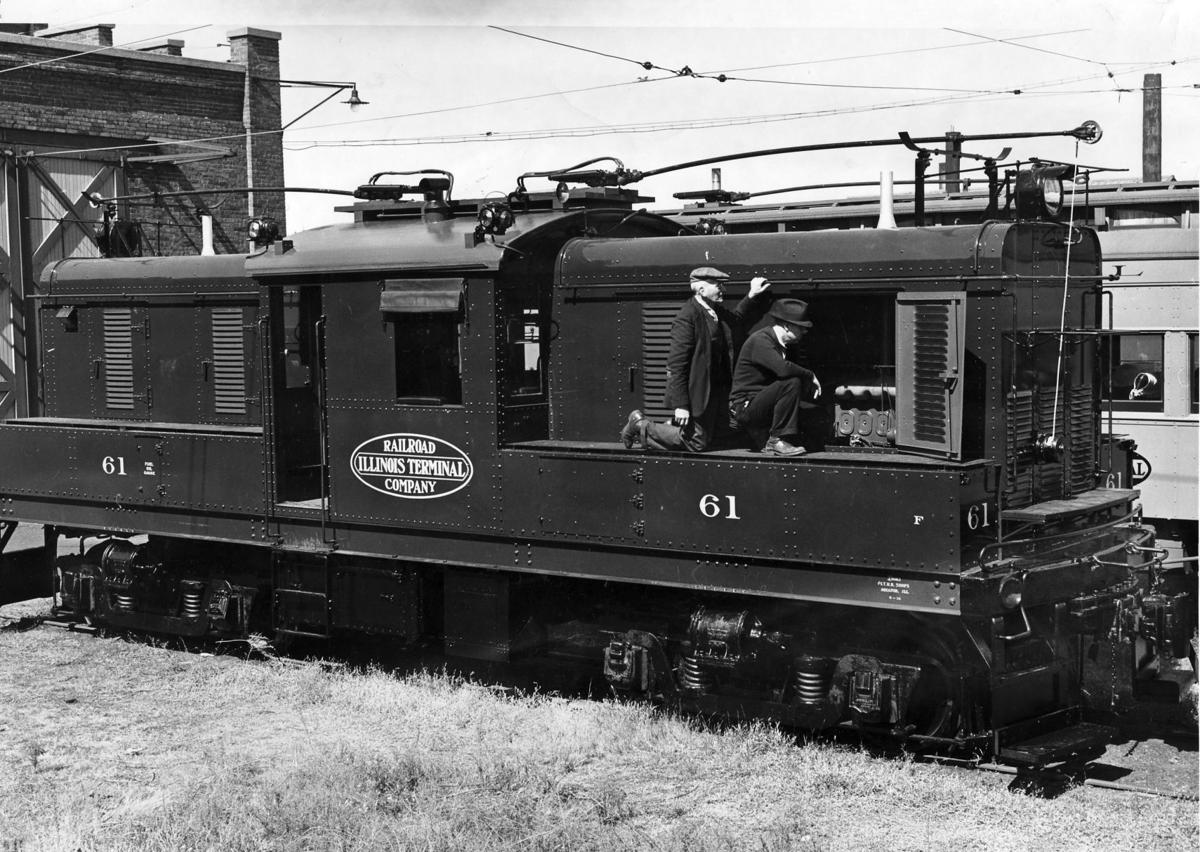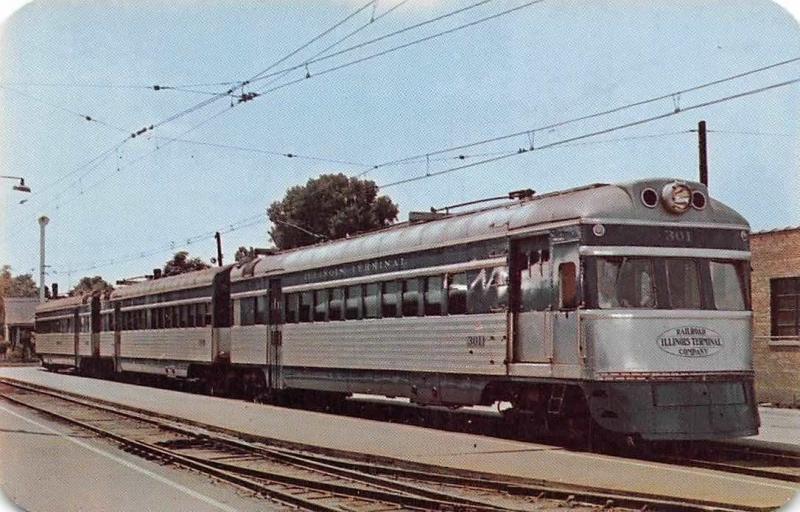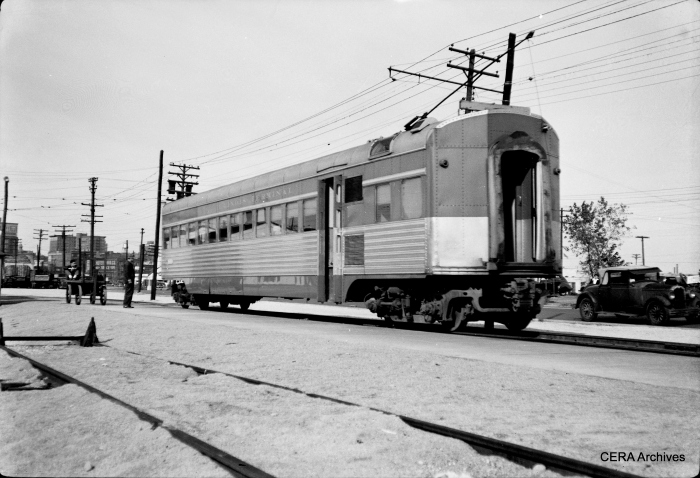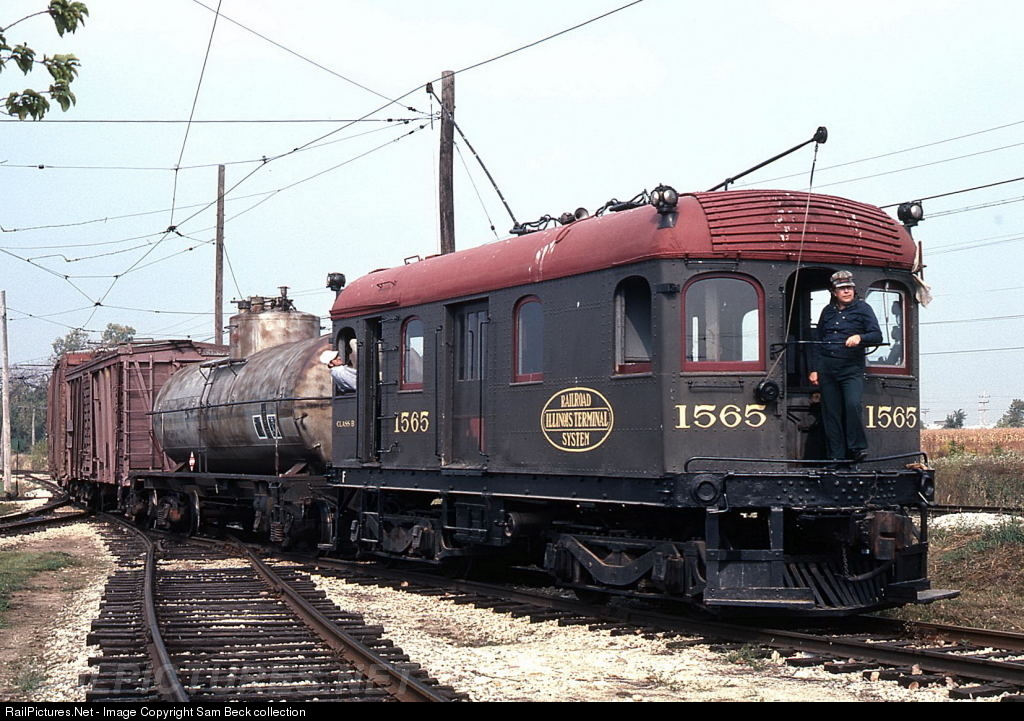 |
Illinois Traction car No. 221 stops at Illiopolis depot, eastbound, in 1907.
(Dale Jenkins, ITS) |
 |
The Honorable William B. McKinley,
who was also a Representative and
Senator for Illinois.
(Library of Congress) |
The Illinois Traction System (ITS) was birthed in 1900 out of several consolidated railroads with a single intent: to connect the major city centers of St. Louis (considered the Gateway to the West, hence the giant arch) and Chicago (where all the railroads connected). What is considered "Illinois Traction" began under William B. McKinley, an investment broker from Champaign, IL, that began his interurban empire by acquiring the Danville Street Railway & Light Company (DSR&L) on July 18, 1900. McKinley's second purchase of the then-defunct Danville, Paxton & Northern (DP&N) absorbed more than 40 miles into his new investment. The next two years were a flurry of work as incorporation of another railroad (the Danville, Urbana & Champaign, his own hometown road) and construction between Georgetown, Westville, Urbana and Champaign brought the railroad to quick operation by November 9, 1902. The headquarters were located in Champaign.
 |
The historic Illinois Traction Station and Headquarters in
Champaign, IL, 2013.
(Beyond My Ken) |
Prior to McKinley's actions, the original promoters of the Illinois Terminal Railroad (that is, the very first one) was planned as a direct main line between the two cities in 1896. Unfortunately, nothing ever came of this attempt, and the Illinois Traction instead fell under McKinley's existing Illinois Power & Light Company. As the ITS stretched further, McKinley made the bold decision to break up construction into several subsidiaries across multiple lines, with much of 1903-1905 being spent building towards Springfield, Staunton, Granite City and Edwardsville. By 1906, McKinley's interurban had reached St. Louis, and already there were issues. Both the community of East St. Louis and the Terminal Railroad Association of St. Louis (TRRA) balked at an interurban line sharing streets or interchange track with the upstart operation, and this convinced McKinley to furnish his own line into the city much, much later. After some tumultuous arguing, both East St. Louis and the TRRA tentatively agreed to let the ITS in via their own subsidiary, the St. Louis & North Eastern. (StL&NE)
 |
A good estimation of the Illinois Terminal's enormous coverage, and yet not a single track towards Chicago...
(American Rails) |
 |
The Chicago, Ottawa & Peoria Railroad, which only got
as far as Joliet Junction.
(Lasalle County Online Museum) |
But what about Chicago? Well, under its own subsidiary of the Chicago, Ottawa & Peoria (CO&P), McKinley purchased the Illinois Valley Railway on April 19, 1907 to inch closer towards Chicago via Joliet, Streator, and Princeton. Unlike the other subsidiaries, this never reached its goal, as it only expanded into Springfield and Decatur during McKinley's lifetime. With so many subsidiaries (four of them by the time the main line opened, and each handling one section of the enormous Y-shaped mainline), you would think McKinley came to realize he split too many eggs in one basket when he should have just had one egg in one basket like his contemporaries. Happily, there was one saving grace to keeping the ITS' early operations afloat: freight.
 |
Class B Freight Motor No. 1566 poses for a promotional
postcard with some of ITS's boxcars, before 1923.
(Public domain.) |
A bygone relic from the original steam railroad concept, car freight was the ITS' main bread and butter as its connections in major Illinois cities and St. Louis meant it was in the perfect position for freight interchange. That the company eventually made millions of dollars from carload freight alone is astonishing, as rival railroads viewed interurbans with disdain for stealing freight and passenger miles from them. The Illinois Central (IC) was one of the more openly-hostile companies as they delayed construction of the ITS' Illinois Central Traction Company (ITC) crossing over the
real IC's line at Capitol Avenue in Springfield. Eventually, the crossing opened as part of (again) another subsidiary, the Springfield Consolidated Railway, between Springfield and Decatur on September 25, 1904. Revenue generated from these freight connections fueled more growth into the 1910s with the (how many subsidiaries will he make?!) St. Louis, Decatur & Champaign Railway connecting Champaign to Danville on June 16, 1907, and the St. Louis Electric Terminal Railway finishing up the final access to downtown St. Louis over the McKinley Bridge on October 1, 1910.
 |
A 1920s postcard of the McKinley River Bridge over the Mississippi, as part of a stock package.
(Illinois Traction Systems) |

 |
Illinois Terminal Class D No. 70, originally Class C No. 1580
(above), rebuilt on September 10, 1940.
(Don Ross) |
In the 1910s, the Illinois Traction operated as any normal interurban of the era, with freight and passenger sharing equal importance. The early roster consisted of wooden interurban cars and locomotives from the local St. Louis Car Company, Danville Car Company, and the American Car & Foundry of St. Charles, Missouri. These standards were split into four classes: Class A steeplecabs built by Danville Car and ALCO-GE in 1907, Class B box motors built by ITS's Decatur shops in 1910, Class C span-bolstered electric locomotives out-shopped by Decatur between 1924-1929, and Class D locomotives which were just Class C's rebuilt with streamlined noses and bigger motors. The B's developed a hardy 800 horsepower, perfect for light freights and switching, while the mighty C and D classes displaced 1000 and 1800 horsepower, respectively, making them the perfect mainline haulers. They all ran on standard 600V DC provided by McKinley's Illinois Power and Light, but originally ran on 33 kilovolt AC, stepped down to 3.3 KV AC at substations, and then to 250 V AC through on-board transformers. It was all too complicated and not to their liking, so it was swapped on July 8, 1909. Illinois Terminal also tested dual- and triple-mode diesel-battery-and-electric locomotives in small numbers starting in 1929, but these were later rebuilt as diesels or normal electric locomotives.
 |
Illinois Terminal No. 61, a diesel-trolley demonstrator
originally built in 1907 by ALCO-GE as Danville Street
Railway & Light No. 102.
(Herald & Review) |
In 1923, the Illinois Power & Light Company (IP&L) subsidized ownership of the ITS in order to maintain the railroad infrastructure. (At this point, the two companies were separate but both directly owned by McKinley.) 1928 saw ITS acquired completely purchased by IP&L for easier consolidation, with the now Illinois Traction Inc. being used as a leasing name. McKinley left IP&L and the railroad business by the restructuring and the railroad fell into different hands, including Clement Studebaker, Jr. (of the prominent automotive family) and Samuel Insull (Remember him?). At the time of Insull's purchase in 1926, the railroad was making $2.2 million ($32 million in 2020 dollars) on freight alone. Despite Insull relinquishing control of the railroad in the Great Depression, the IT’s freight service kept it economically viable enough to kindly convince the Wabash and Illinois Central to electrify their tracks through Champaign and Urbana. This way, IT had the advantage of switching locally while the bigger railroads would not feel as threatened by the freight interurban.
 |
PCC 454, "Not-Hollywood" 471, and Class B 1576
(still in wartime "War Bonds" scheme) pose at ITC's
Granite, IL yard, 1954. The 470s were built with
blanked-out upper window sashes as standard.
(Western Rail Images) |
By some miracle, the ITS flourished in the 1930s and began purchasing newer interurban cars to satisfy their aging fleet of wooden interurbans. This meant lavishly appointed cars like the "Champaign" party trailer (a 1908 Danville product that was rebuilt into a parlor trailer) and 1913-era steel cars constructed by St. Louis Car gave way to newer rolling stock, much smaller than the giant interurban cars but just as plentiful. Remember that disconnected subsidiary that never reached Chicago, the Chicago Ottawa & Peoria? They started investing in handsome arched roof branch line cars in 1924 with the 400-series "city" cars. They were soon joined by some familiar faces in the form of the 470-series cars. These St. Louis products were originally built for the East St. Louis & Suburban Railway (EStL&S, whose Alton Line was purchased by the ITS) in 1924 as a tack-on to the Pacific Electric's enormous 650-699 car order from the same year. Having considered the PE's new center entrance cars perfect for suburban use, EStL&S requested bigger trucks and larger motors to make them true "interurbans" rather than just "city cars".
 |
In 1977, the Cleveland RTA pulled
then-privately owned ITC PCC 450
from the Ohio Railroad Museum due to
equipment shortages.
(CERA Archives) |
By 1937, the railroad had reorganized itself again as the Illinois Terminal Railroad Company (ITC) and was separated from the Illinois Light & Power Company under the Public Utility Holding Company Act of 1935. This also meant that all city streetcars were cut, including the EStL&S and the Chicago Ottawa & Peoria. Unable to fight the rising tide of automobile ownership following WWII, the ITC threw itself into investing in newer rolling stock to keep itself viable to passengers. One new purchase was an order of eight double-ended PCC cars from St. Louis Car Company in 1949, similar to the ones Pacific Electric also ordered a decade earlier. The main difference came from the IT PCCs only having one set of end doors on either side (a national rarity), but unlike most PCCs around this time, these were capable of multiple-unit operation.
The other big purchase had been in the works since 1947 for a brand-new limited service between Peoria and St. Louis. These were dubbed the "Streamliners", and the three 80-mile per hour electric multiple sets were just futuristic and flashy enough to bring people back to riding the interurban. Inside were amenities lifted straight from the North Shore's Electroliner: a parlor car, a la carte dining service, and a fast 4:40 journey time between St. Louis and Peoria. Unfortunately, the City of Decatur, Fort Crevecoeur, and Mound City all had problems for the start. It was eventually found none of the three trainsets could fit at either St. Louis' Subway Loop or Peoria's interurban terminal due to clearance issues, so the only option was to decouple all three cars and back them in one by one. Poor passenger numbers also reduced these train sets to two-car operation by December 1949, and they limped along embarrassingly until they were retired, along with the rest of Illinois Terminal's fleet, in 1956. Dubiously, the "Streamliners" were the last interurban cars ever built in America.
 |
The Illinois Terminal's "Streamliners", fresh out of the St. Louis Car Company's shops in 1947...
(American Rails) |
 |
...and how a normal operation at East Peoria usually ended. This is a parlor car, which also
had hostler controls inside for yard movement. Disturbingly, the trains would not be scrapped until the 1980s.
(CERA) |
 |
A train of St. Louis-built steel cars, led by the drum-headed
ITC 532, pauses for photos and dithering at St. Louis during
an NHRS special, September 6, 1953.
(CERA) |
The Illinois Terminal spent its last couple of years entertaining the members of the Chicago Electric Railway Association and the National Railway Historical Society, whose charters created a plethora of color and monochrome photographs. After 1956, the Illinois Terminal was purchased by a consortium of nine railroads intent on making it an interchange road, including: the Baltimore & Ohio (B&O), Rock Island (CRIP), Frisco (SLSF), Gulf Mobile & Ohio (GMO), the Burlington Route (CB&Q), Illinois Central (IC), Litchfield & Madison, New York Central (NYC), the Nickel Plate Road (NYC&StL), and the Wabash. Eventually, the ITC folded into the Norfolk & Western in 1982, where it continues as an interchange railroad.
 |
Illinois Terminal No. 450 crosses the Ohio Railway Museum's
bridge in Worthington, Ohio, 2012.
(Todd Dillon) |
The many impressive locomotives and passenger cars would be scrapped or find private owners, eventually winding their way into museum ownership, including PCC 450 at the Ohio Railroad Museum, sister PCC 451 at the Connecticut Trolley Museum in East Windsor, and Class B freight motor 1565 at the Illinois Railroad Museum (which also owns most of the operating interurban cars too like the "Champaign" party trailer). The San Francisco's Market Street Railway also dedicated one of their double-ended PCCs in Illinois Terminal Finery, numbered 1015. William B. McKinley's headquarters in Champaign, IL survives as a historic building, while the bridge that bears his name in St. Louis functions as primarily a road bridge today. Hilariously, people still think it's named after the US President of the same name.
 |
Illinois Terminal Class B No. 1565 poses with a photo freight at the Illinois Railway Museum, October, 1982.
(Tom Golden) |
Thank you for reading today's belated Trolley Thursday post! I'd like to credit
Jonathan Lee for serving as this month's Chicago transit expert, as well as
Victoria Broskie, Vice President of the Ohio Railway Museum, for information about PCC No. 450. If you would like to learn more about the Illinois Central 650 and other survivors, click the museum links provided for more information:
The Illinois Railroad Museum,
The Ohio Railroad Museum,
The Connecticut Trolley Museum. Next week, we look at the Pullman Car Company's streetcar endeavors before finishing the month off with a guest post by Jonathan Lee. Until next week, you can follow
myself or
my editor on twitter if you wanna support us, and maybe
buy a shirt as well! Ride safe out theah!























No comments:
Post a Comment